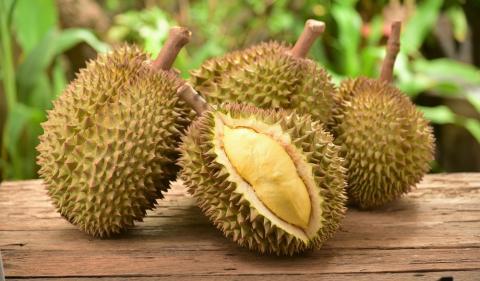
Durian is a member of the family Bombacaceae or Kapok-tree family of the genus Durio Adanson, also known as durio P, containing one species Durio zibethinus Murray, commonly known as durian P. according to the United States Department of Agriculture (USDA). The genus is native to the island of Borneo and other sources confirm twenty-seven species found throughout the south Pacific islands, southeast Asia, southern India, and northern regions of Australia. Of the twenty-seven species only six produce edible fruit and are produced commercially in southeast Asia. The name durian is derived from the Malayan language “duri” meaning thorn and refers to the tree, the fruit and its flesh, and the pulp. In southeast Asia and China it is known as the King of Fruits and its popularity can be found in Taiwan, Canada, Europe, and the United States. Europeans traveling in the tropics discovered the plant in the 15th century. The plant was documented by G.E. Rumphius, a German botanist in his book "Herbarium Amboinense" in 1741.
Durian grows on trees that produce fruit that is round or oblong with a hard, thorny outer skin and ranges in size from approximately six to twelve inches in length, weighing about six-and-one half pounds. The outer skin of the fruit can be either green or brown with flesh that can be either luminous yellow or hues of red. The flowers grow from the main trunk and larger branches in clusters from three to thirty identical blooms, each having sepals and from five to six petals. The fruit has a distinct odor and can be detected from a long distance.
Harvesting & Eating Durian
When harvesting durian it is suggested to wear a hard hat because the falling fruit could cause injury much like a coconut. Durian is ripe after it falls from the tree. It may have a slight crack from the fall which helps in opening the fruit by inserting a knife or cleaver into the crack. Inside there are approximately five sections containing several seeds that can be eaten after they are cooked.
When eaten just after it falls from the tree the odor is quite pungent and the flavor is intense. The fruit can be made into milkshakes, used in Yule logs, added as an ingredient in cappuccinos, and added to rice and other Asian dishes. It is the main ingredient in the Malaysian dish Tempoyak.
Health Benefits of Durian
Durian is rich in vitamin C and has a high sugar content. The fruit also contains potassium, carbohydrates, tryptophan, proteins, and fats. Its raw fat is recommended by health professionals but should be taken in moderation. Research done at the University of Tsukuba found the fruit significant in detoxifying the body. In Malaysia the leaves and roots are used to control fever.
There are several health benefits in durian that include boosting the immune system, improving digestion, and reducing the incidence of insomnia. It is used as a cancer preventative due to its ability to destroy free radicals. It protects the body from cardiovascular diseases, prevents premature aging, strengthens the skeletal system, and lowers blood pressure. It is also known to manage diabetes, reduce joint inflammation, and lower the incidence of stress, depression, and anxiety.
A Unique Aroma
The unusual aroma of durian has been studied by scientists in Germany, who by breaking down its chemical makeup found fifty compounds that cause the scent of the fruit. It is this composite of chemicals that causes the powerful smell that can be either pleasant to some or putrid to others.








